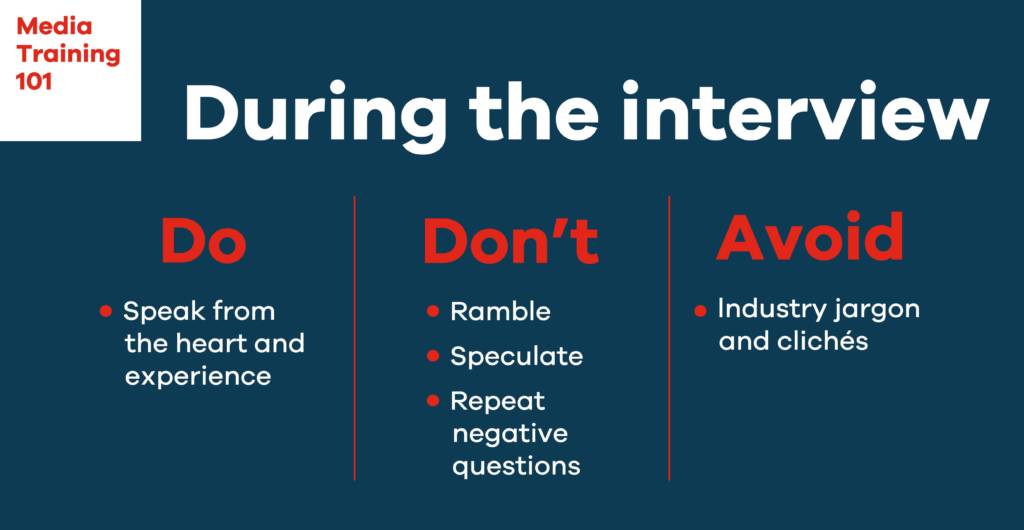Nine Tips for Nailing a Media Interview

Does receiving an interview request send you into an instant panic and a cold sweat? Are you one of the 75% of people who suffer from glossophobia, a fear of public speaking? Would you rather do pretty much anything other than sitting in front of a camera and talking to a reporter?
Brands, we have news for you – like it or not, now is your time to step up and take the interview! According to a recent Pew Research and Nielsen report, overall news consumption by adults has increased by 18 percent – people are tuning in! Plus, in an era plagued with Americans’ distrust for the media, it is more important now than ever for companies to get out and speak on behalf of themselves.
Knowing how stressful this situation can be, The Martin Group has created an intensive media training seminar to catch companies up to speed. With more than 30 training sessions with WNY companies under our belt, we homed in on the top nine tips for nailing a media interview.
- Tell a good story. Do this by keeping in mind the following three points –
- What is the impact of my story on the community? The more impactful and relevant, the better.
- Does this story – and my delivery of the story – convey emotion? Emotion draws the viewers in and enhances believability.
- Is my story visual? And are we providing a visual component to viewers via a product, photos or video?
- Preparation is Key.
- Get a firm grasp on the story the reporter is looking to tell. This will help determine the goal of the interview, set parameters and allow you to properly prepare for potential questions.
- Identify the key messages you need to communicate.
- Anticipate questions and plan your answers in advance.
- Practice, practice, practice. Whether you are role playing with another person, looking into a bathroom mirror or alone in your bedroom recording yourself on your iPhone – practice makes perfect you significantly less nervous.
- Remember the Rule(s) of Three.
- Commit three key messages to memory walking into the interview.
- Each message should abide by the following three rules – be short and sweet, leverage facts and figures, convey stories and emotion.
- Look the Part. While authenticity during an interview is important to building confidence and trust in a company spokesperson, keep in mind a handful of no-no’s while on camera.
- Avoid distracting hand gestures and swaying. While gesticulating can be an effective way to engage audiences during a presentation, in a media interview – it can be entirely distracting. Try to keep your arms down by your side and maintain solid footing to prevent swaying.
- Dress simply. Avoid patterned shirts, clunky jewelry or dangly earrings, as they could potentially distract viewers.
- Channel the mood. Dress appropriately for the interview topic. If it is a crisis scenario, veer on the side of formal and conservative. If it is a light-hearted brand interview, dress to reflect the essence of the brand (bankers dress more conservative, startup founders are more casual, etc.)
- Flag Away! One great technique to ensure your most important key message doesn’t find its way to the cutting room floor is to “flag” it for the reporter. Solid flagging phrases include “if you remember one thing, it should be” and “the most important takeaway is.” Find one you are the most comfortable delivering and use it as your crutch.
- Speak in Sound Bites. In a typical 2-3-minute broadcast interview, the average sound bite is approximately 10-15 seconds in length. Remember this when planning and delivering your key messages. It will greatly enhance the likelihood of your key message making the final cut.
- Create a Call to Action. The majority of brand-focused interviews share a similar underlined goal – increase sales, build brand awareness, drive traffic, etc. To help achieve this goal, ensure that you are communicating a clear call to action for viewers. Whether it’s visit our website, swing by the store, buy this product – tell viewers exactly what you want them to do.
- Dumb it Down. It’s easy to fall into the habit of using industry jargon. Assume your audience is completely unfamiliar with your industry. A good rule of thumb is to speak at an 11th grade level.
- Bridge and Block Off-Topic Questions. It is bound to happen. You’ll be in full stride during an interview and all of the sudden, you are hit with a question out of left field. Whether you don’t know the answer, or you aren’t at liberty to discuss the answer, employ a simple block and bridge technique to regain control over the interview. For example, if asked a problem, block it and talk about the solution – “That’s an interesting question.” (block) – “However, what is more important to look at is…” (bridge).